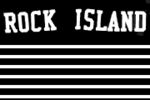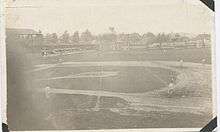Rock Island Independents
 | |
| Founded | 1907 |
|---|---|
| Folded | 1926 |
| Based in | Rock Island, Illinois, United States |
| League |
National Football League (1920–25) American Football League (1926) |
| Team history | Rock Island Independents (1920–26) |
| Team colors |
Green and white |
| Head coaches |
Rube Ursella (1920, 1925) Frank Coughlin (1921) Jimmy Conzelman (1921–22) Herb Sies (1923) Johnny Armstrong (1924, 1926) |
| General managers |
Walter Flanigan (1920–23) Vince McCarthy (1924–26) |
| Owner(s) |
Walter Flanigan (1920–23) Dale Johnson (1923–26) |
| Other League Championship wins | (1) 1919 (self-proclaimed) |
| Undefeated seasons | (5) 1908, 1910, 1912, 1913, 1918 |
| Home field(s) |
Douglas Park (1920–1926) Browning Field (1926) |
| Fan website | http://www.rockislandindependents.com/ |
The Rock Island Independents were a professional American football team based in Rock Island, Illinois from 1920-1926. The Independents are credited with hosting and playing in the "first" NFL Game on September 26, 1920. [1][2] Pro Football Hall of Fame alumni Jimmy Conzelman (1920–1921), Joe Guyon (1924), Ed Healey (1920–1922) and Jim Thorpe (1924–1925) played for the Independents.
History
One of the first professional football teams, they were founded in 1907 by Demetrius Clements as an independent club. They played in the American Professional Football Association (later renamed the National Football League (NFL) in 1922) from 1920 to 1925 and are credited playing with the first league contest on September 26 1920. They joined the first American Football League in 1926, but folded along with the league in 1927. They played in Douglas Park (1907–1925) and Browning Field (1926). Walter Flanigan owned the team from 1915 to 1923; Dale Johnson took over and owned the team until 1926, when the team eventually folded.[3]
The Independents' overall NFL record was 26–14–9, with five winning seasons in six years. However, after finishing fourth initially, their best overall finish in the National Football League standings was fifth, which they accomplished three times: in 1921 and 1922 under Jimmy Conzelman, and in 1924 under Johnny Armstrong.[4]
Origins
The Independents were first formed in 1907, when a group of men formed an independent team with no athletic club affiliation, no social club ties and no corporate company backing or sponsorship. As a result, the team was named the Independents. The team went undefeated and unscored upon in five games. Many of the same players from that 1910 team reunited in 1912; under the leadership of John Roche, they won eight games without giving up a score.
Walter Flanigan era
In 1913 Walter Flanigan joined the Independents as a backup end. By 1915, Flanigan was the owner of the team. During his tenure, Flanigan promoted the Independents by scheduling two games in 1917 against the Minneapolis Marines, who were considered one of the toughest teams in the Midwest. This contest helped the Independents gain national attention. Rock Island lost to the Marines by a score of 7–3. However, they were defeated by a wider margin, 33–7, in the second game at Minneapolis.


Flanigan then brought in players from outside the Rock Island area to build on the team. In 1919, he hired Rube Ursella of the Marines to serve as a player-coach. Ursella brought several other Minneapolis players with him. These new players would later help get the team an invitation to join the NFL. The Independents lost only to the Hammond Pros, led by George Halas in 1919. Flanigan then challenged the Canton Bulldogs to a "championship" game, offering a $5,000 guarantee if they would come to Rock Island for the game. But Canton, which had already won the "Ohio League" championship by defeating their arch-rivals, the Massillon Tigers, turned down the offer. It is likely that Canton's Jim Thorpe and Ralph Hay learned that Rock Island's game against the Akron Indians had drawn only 1,700 spectators and felt that Flanigan could not deliver on his $5,000 guarantee, that was money that came primarily from the gate. However, the Independents still had defeated the Columbus Panhandles 49–0 and the Indians 17–0 that season. In 1919, prior to the establishment of the National Football League, they claimed to be "Champions of the USA".[5]
National Football League (NFL)
Flanigan and the Independents eagerly joined the new American Professional Football Association (APFA) (later renamed the National Football League in 1922). He was present at the September 17, 1920, meeting at Ralph Hay's Hupmobile dealership which established the league. Flanigan made his team a card-carrying charter member of the league and he was named to a committee charged with framing the league's constitution.
First Ever NFL Game
On September 26, 1920, the Independents hosted the first official game featuring a team from the APFA. [6] Thus, Douglas Park was the site of the first ever National Football League contest on September 26, just 9 days after the league had formed on September 17, 1920, when the Independents defeated the non-member St. Paul Ideals 48-0 in the new league's first contest.[7][8]
A week later, on October 3, 1920, the Independents defeated the Muncie Flyers 45-0 at Douglas Park in the first full week of league play.[9][10] 3,100 fans were in attendance as Arnie Wyman, former Minnesota great, made his debut for the Islanders, scoring three touchdowns. This might have been the 1st NFL game ever played with two NFL teams, however, NFL historical records don't indicate the kickoff time for this game or the other APFA game played that day between the Dayton Triangles and the Columbus Panhandles in Dayton, Ohio. [11]
Dale Johnson era
In 1923 Flanigan left the team to concentrate on his real estate and insurance businesses. Dale Johnson, another local businessman, took over as the team's owner, with the team's backup quarterback Vince McCarthy acting as manager, with Rock Island High School alumni and Olympian Sol Butler joining the squad. Rock Island went 2–3–3 that season, however they did post winning seasons in 1924 and 1925. Jim Thorpe, considered "the World's Greatest Athlete", joined the Independents in 1924 and the team went 5–2–2 in league play. After the 1925 season they toured nationally to promote pro football, often under the name "Tampa Cardinals".[12]
First American Football League (AFL)
In 1926, Red Grange and his manager, C. C. Pyle, formed the first American Football League after a dispute over granting Pyle ownership of an NFL franchise in New York City. Thinking that having a league centered on Grange would lead to higher profits, McCarthy pulled Rock Island out of the NFL and joined the new league. The Independents were the only NFL team to make the jump to the rival league. However, the new league did not pay as much as the NFL did a year prior. Several players left the Independents for bigger salaries with other teams. As a result, the Independents ended their season with a 2–6–1 record. The AFL folded and the Independents were not allowed to rejoin the NFL. They played as a minor, semi-pro team in 1927, then went out of business.[13]
Pro Football Hall of Fame alumni
- Jimmy Conzelman (1921-1922) Inducted, 1964
- Joe Guyon (1924) Inducted, 1966
- Ed Healey (1920-1922) Inducted, 1964
- Jim Thorpe (1924-1925) Inducted, 1963
Season-by-season
| Year | W | L | T | Finish | Coach | |
|---|---|---|---|---|---|---|
| 1907 | 2 | 3 | 1 | |||
| 1908 | 4 | 0 | 0 | |||
| 1909 | 0 | 3 | 0 | |||
| 1910 | 5 | 0 | 0 | |||
| 1911 | Did Not Play | |||||
| 1912 | 8 | 0 | 0 | Dick Liitt | ||
| 1913 | 6 | 0 | 1 | Dick Liitt | ||
| 1914 | 5 | 2 | 0 | Joseph Smith | ||
| 1915 | 5 | 1 | 1 | Walter Flanigan | ||
| 1916 | 5 | 3 | 1 | Walter Flanigan | ||
| 1917 | 7 | 3 | 0 | Ted Guyer | ||
| 1918 | 5 | 0 | 0 | Walter Flanigan | ||
| 1919 | 9 | 1 | 1 | Rube Ursella, John Roche | ||
| Joined the American Professional Football Association | ||||||
| 1920 | 6 | 2 | 2 | 3rd | Rube Ursella | |
| 1921 | 4 | 2 | 1 | 5th | Frank Coughlin, Jimmy Conzelman | |
| AFPA is renamed the National Football League | ||||||
| 1922 | 4 | 2 | 1 | 5th | Jimmy Conzelman | |
| 1923 | 2 | 3 | 3 | 12th | Herb Sies | |
| 1924 | 5 | 2 | 2 | 5th | Johnny Armstrong | |
| 1925 | 5 | 3 | 3 | 8th | Rube Ursella | |
| Moved to American Football League (1926) | ||||||
| 1926 | 2 | 6 | 1 | 7th | Johnny Armstrong | |
| AFPA/NFL-AFL Totals | 28 | 20 | 13 | |||
References
- Peterson, Robert W. (1997). Pigskin: The Early Years of Pro Football. Oxford University Press. ISBN 0-19-511913-4.
- Braunwart, Bob & Bob Carroll (1983). "The Rock Island Independents" (PDF). Coffin Corner. Professional Football Researchers Association. 5 (3): 1–7. Archived from the original (PDF) on October 22, 2012.
- Braunwart, Bob & Bob Carroll (1981). "The First NFL Game(s)" (PDF). Coffin Corner. Professional Football Researchers Association. 3 (2): 1–4. Archived from the original (PDF) on March 2, 2012.
- Rock Island Independents Historical Site
References
- ↑ http://www.profootballhof.com/news/nfl-founded-in-canton/
- ↑ https://www.pro-football-reference.com/boxscores/192009260rii.htm
- ↑ Peterson, Robert W. (1997). Pigskin: The Early Years of Pro Football. Oxford University Press. ISBN 0-19-511913-4.
- ↑ Braunwart, Bob & Bob Carroll (1983). "The Rock Island Independents" (PDF). Coffin Corner. Professional Football Researchers Association. 5 (3): 1–7. Archived from the original (PDF) on October 22, 2012.
- ↑ Braunwart, Bob & Bob Carroll (1983). "The Rock Island Independents" (PDF). Coffin Corner. Professional Football Researchers Association. 5 (3): 1–7. Archived from the original (PDF) on October 22, 2012.
- ↑ http://www.profootballhof.com/history/decades/1920s/founded.aspx
- ↑ http://www.profootballhof.com/news/nfl-founded-in-canton/
- ↑ https://www.pro-football-reference.com/boxscores/192009260rii.htm
- ↑ https://www.pro-football-reference.com/years/1920_APFA/
- ↑ https://www.pro-football-reference.com/teams/rii/1920_games.htm
- ↑ "Archived copy" (PDF). Archived from the original (PDF) on March 2, 2012. Retrieved June 9, 2011.
- ↑ Braunwart, Bob & Bob Carroll (1983). "The Rock Island Independents" (PDF). Coffin Corner. Professional Football Researchers Association. 5 (3): 1–7. Archived from the original (PDF) on October 22, 2012.
- ↑ Braunwart, Bob & Bob Carroll (1983). "The Rock Island Independents" (PDF). Coffin Corner. Professional Football Researchers Association. 5 (3): 1–7. Archived from the original (PDF) on October 22, 2012.
